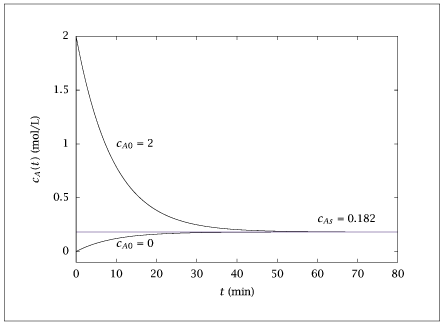% Copyright (C) 2001, James B. Rawlings and John G. Ekerdt
%
% This program is free software; you can redistribute it and/or
% modify it under the terms of the GNU General Public License as
% published by the Free Software Foundation; either version 2, or (at
% your option) any later version.
%
% This program is distributed in the hope that it will be useful, but
% WITHOUT ANY WARRANTY; without even the implied warranty of
% MERCHANTABILITY or FITNESS FOR A PARTICULAR PURPOSE. See the GNU
% General Public License for more details.
%
% You should have received a copy of the GNU General Public License
% along with this program; see the file COPYING. If not, write to
% the Free Software Foundation, 59 Temple Place - Suite 330, Boston,
% MA 02111-1307, USA.
% This script file solves the multimedia example STR_CSTR
% that illustrates how a STR approaches the steady state and
% becomes a CSTR at sufficiently long time.
% It was developed February 1999, last edited February 8, 1999.
%
% This program is modified here for an example to be inserted into the text
% Last edited by Ekerdt on June 15, 2001
% Revised 7/24/2018
p = struct();
p.caf = 2; %gmoles/liter
%cao = input('Enter the initial concentration of A in gmole/liter. ');
%k = input('Enter the rate constant in min^{-1}. ');
%theta = input('Enter the reactor residence time in min. ');
%tf = input('Enter the integration time in min. ');
%set the default values at cao = 0, k = 0.1, theta = 100, tf = 120
%disp('The steady state reactor concentration of A in gmole/liter is ')
p.cao = 0;
p.k = 0.1;
p.theta = 100;
tf = 120;
c_ss = p.caf/(1 + p.k*p.theta);
t = [0:.1:tf]';
c_o = [p.cao];
tff = (10*tf)+1;
opts = odeset ('AbsTol', sqrt (eps), 'RelTol', sqrt (eps));
[tsolver, solution] = ode15s (@(t,x) mat_bal(t,x,p), t, c_o, opts);
answer = [t solution c_ss*ones(tff,1)];
p.cao = 2.0;
c_o = [p.cao];
opts = odeset ('AbsTol', sqrt (eps), 'RelTol', sqrt (eps));
[tsolver, solution1] = ode15s (@(t,x) mat_bal(t,x,p), t, c_o, opts);
answer1 = [t solution1 c_ss*ones(tff,1)];
answer = [answer solution1];
save -ascii strcstr.dat answer;
if (~ strcmp (getenv ('OMIT_PLOTS'), 'true')) % PLOTTING
plot (answer(:,1), answer(:,[2,4,3]));
% TITLE
end % PLOTTING
